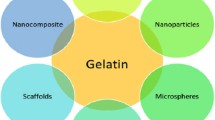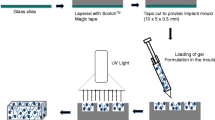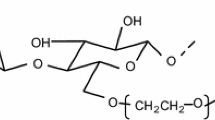Abstract
Biocompatibility is a major requirement for the development of functional biomaterials for ophthalmic applications. In this study, we investigated the effect of cross-linker functionality on ocular biocompatibility of chemically modified gelatin hydrogels. The test materials were cross-linked with glutaraldehyde (GTA) or 1-ethyl-3-(3-dimethyl aminopropyl)carbodiimide (EDC), and were analyzed using in vitro and in vivo assays. Primary rat iris pigment epithelial cultures were incubated with various gelatin discs for 2 days, and the cellular responses were monitored by cell proliferation, viability, and pro-inflammatory gene and cytokine expression. The results demonstrated that the cells exposed to EDC cross-linked gelatins had relatively lower lactate dehydrogenase activity, cytotoxicity, and interleukin-1β and tumor necrosis factor-α levels than did those to GTA treated samples. In addition, the gelatin implants were inserted in the anterior chamber of rabbit eyes for 12 weeks and characterized by clinical observations and scanning electron microscopy studies. The EDC cross-linked gelatin hydrogels exhibited good biocompatibility and were well tolerated without causing toxicity and adverse effects. However, a significant inflammatory reaction was elicited by the presence of GTA treated materials. It was noted that, despite its biocompatibility, the potential application of non-cross-linked gelatin for local delivery of cell and drug therapeutics would be limited due to rapid dissolution in aqueous environments. In conclusion, these findings suggest ocular cell/tissue response to changes in cross-linker properties. In comparison to GTA treatment, the EDC cross-linking is more suitable for preparation of chemically modified gelatin hydrogels for ophthalmic use.








Similar content being viewed by others
References
Lai JY, Hsiue GH. Functional biomedical polymers for corneal regenerative medicine. React Funct Polym. 2007;67:1284–91.
Li F, Carlsson D, Lohmann C, Suuronen E, Vascotto S, Kobuch K, et al. Cellular and nerve regeneration within a biosynthetic extracellular matrix for corneal transplantation. Proc Natl Acad Sci USA. 2003;100:15346–51.
Nishida K, Yamato M, Hayashida Y, Watanabe K, Yamamoto K, Adachi E, et al. Corneal reconstruction with tissue-engineered cell sheets composed of autologous oral mucosal epithelium. N Engl J Med. 2004;351:1187–96.
Hsiue GH, Lai JY, Chen KH, Hsu WM. A novel strategy for corneal endothelial reconstruction with a bioengineered cell sheet. Transplantation. 2006;81:473–6.
Lai JY, Lu PL, Chen KH, Tabata Y, Hsiue GH. Effect of charge and molecular weight on the functionality of gelatin carriers for corneal endothelial cell therapy. Biomacromolecules. 2006;7:1836–44.
Lai JY, Chen KH, Hsu WM, Hsiue GH, Lee YH. Bioengineered human corneal endothelium for transplantation. Arch Ophthalmol. 2006;124:1441–8.
Lai JY, Chen KH, Hsiue GH. Tissue-engineered human corneal endothelial cell sheet transplantation in a rabbit model using functional biomaterials. Transplantation. 2007;84:1222–32.
Hsiue GH, Lai JY, Lin PK. Absorbable sandwich-like membrane for retinal-sheet transplantation. J Biomed Mater Res. 2002;61:19–25.
Lai JY, Lin PK, Hsiue GH, Cheng HY, Huang SJ, Li YT. Low Bloom strength gelatin as a carrier for potential use in retinal sheet encapsulation and transplantation. Biomacromolecules. 2009;10:310–9.
Vandervoort J, Ludwig A. Preparation and evaluation of drug-loaded gelatin nanoparticles for topical ophthalmic use. Eur J Pharm Biopharm. 2004;57:251–61.
Hori K, Sotozono C, Hamuro J, Yamasaki K, Kimura Y, Ozeki M, et al. Controlled-release of epidermal growth factor from cationized gelatin hydrogel enhances corneal epithelial wound healing. J Control Release. 2007;118:169–76.
Sakai T, Kuno N, Takamatsu F, Kimura E, Kohno H, Okano K, et al. Prolonged protective effect of basic fibroblast growth factor-impregnated nanoparticles in Royal College of Surgeons rats. Invest Ophthalmol Vis Sci. 2007;48:3381–7.
Touny AH, Laurencin C, Nair L, Allcock H, Brown PW. Formation of composites comprised of calcium deficient HAp and cross-linked gelatin. J Mater Sci Mater Med. 2008;19:3193–201.
Bigi A, Cojazzi G, Panzavolta S, Rubini K, Roveri N. Mechanical and thermal properties of gelatin films at different degrees of glutaraldehyde crosslinking. Biomaterials. 2001;22:763–8.
Sisson K, Zhang C, Farach-Carson MC, Chase DB, Rabolt JF. Evaluation of cross-linking methods for electrospun gelatin on cell growth and viability. Biomacromolecules. 2009;10:1675–80.
Nishi C, Nakajima N, Ikada Y. In vitro evaluation of cytotoxicity of diepoxy compounds used for biomaterial modification. J Biomed Mater Res. 1995;29:829–34.
Tomihata K, Ikada Y. Cross-linking of gelatin with carbodiimides. Tissue Eng. 1996;2:307–13.
Kuijpers AJ, Engbers GHM, Krijgsveld J, Zaat SAJ, Dankert J, Feijen J. Cross-linking and characterisation of gelatin matrices for biomedical applications. J Biomater Sci Polym Ed. 2000;11:225–43.
Yoshioka SA, Goissis G. Thermal and spectrophotometric studies of new crosslinking method for collagen matrix with glutaraldehyde acetals. J Mater Sci Mater Med. 2008;19:1215–23.
Ichikawa Y, Noishiki Y, Kosuge T, Yamamoto K, Kondo J, Matsumoto A. Use of a bovine jugular vein graft with natural valve for right ventricular outflow tract reconstruction: a one-year animal study. J Thorac Cardiovasc Surg. 1997;114:224–33.
Lai JY. The role of Bloom index of gelatin on the interaction with retinal pigment epithelial cells. Int J Mol Sci. 2009;10:3442–56.
Lu PL, Lai JY, Ma DHK, Hsiue GH. Carbodiimide cross-linked hyaluronic acid hydrogels as cell sheet delivery vehicles: characterization and interaction with corneal endothelial cells. J Biomater Sci Polym Ed. 2008;19:1–18.
Matsuda S, Iwata H, Se N, Ikada Y. Bioadhesion of gelatin films crosslinked with glutaraldehyde. J Biomed Mater Res. 1999;45:20–7.
Lu PL, Lai JY, Tabata Y, Hsiue GH. A methodology based on the “anterior chamber of rabbit eyes” model for noninvasively determining the biocompatibility of biomaterials in an immune privileged site. J Biomed Mater Res A. 2008;86:108–16.
Fukunaka Y, Iwanaga K, Morimoto K, Kakemi M, Tabata Y. Controlled release of plasmid DNA from cationized gelatin hydrogels based on hydrogel degradation. J Control Release. 2002;80:333–43.
Chou YF, Huang W, Dunn JCY, Miller TA, Wu BM. The effect of biomimetic apatite structure on osteoblast viability, proliferation, and gene expression. Biomaterials. 2005;26:285–95.
Katz EP, Li ST. The intermolecular space of reconstituted collagen fibrils. J Mol Biol. 1973;73:351–69.
Liang HC, Chang WH, Lin KJ, Sung HW. Genipin-crosslinked gelatin microspheres as a drug carrier for intramuscular administration: in vitro and in vivo studies. J Biomed Mater Res A. 2003;65:271–82.
Burugapalli K, Thapasimuttu A, Chan JCY, Yao L, Brody S, Kelly JL, et al. Scaffold with a natural mesh-like architecture: isolation, structural, and in vitro characterization. Biomacromolecules. 2007;8:928–36.
Park JU, Tsuchiya T. Increase in gap-junctional intercellular communications (GJIC) of normal human dermal fibroblasts (NHDF) on surfaces coated with high-molecular-weight hyaluronic acid (HMW HA). J Biomed Mater Res. 2002;60:541–7.
Lai JY, Ma DHK, Cheng HY, Sun CC, Huang SJ, Li YT, et al. Ocular biocompatibility of carbodiimide cross-linked hyaluronic acid hydrogels for cell sheet delivery carriers. J Biomater Sci Polym Ed. 2010;21:359–76.
Brodbeck WG, Voskerician G, Ziats NP, Nakayama Y, Matsuda T, Anderson JM. In vivo leukocyte cytokine mRNA responses to biomaterials are dependent on surface chemistry. J Biomed Mater Res A. 2003;64:320–9.
Kim DH, Novak MT, Wilkins J, Kim M, Sawyer A, Reichert WM. Response of monocytes exposed to phagocytosable particles and discs of comparable surface roughness. Biomaterials. 2007;28:4231–9.
Sandeman SR, Jeffery H, Howell CA, Smith M, Mikhalovsky SV, Lloyd AW. The in vitro corneal biocompatibility of hydroxyapatite coated carbon mesh. Biomaterials. 2009;30:3143–9.
Abe T, Takeda Y, Yamada K, Akaishi K, Tomita H, Sato M, et al. Cytokine gene expression after subretinal transplantation. Tohoku J Exp Med. 1999;189:179–89.
Joffe KM, Raymond JE, Chrichton A. Motion coherence perimetry in glaucoma and suspected glaucoma. Vision Res. 1997;37:955–64.
Ehlers N, Hjortdal J. Corneal thickness: measurement and implications. Exp Eye Res. 2004;78:543–8.
Setälä K. Corneal endothelial cell density after an attack of acute glaucoma. Acta Ophthalmol (Copenh). 1979;57:1004–13.
Williams CG, Malik AN, Kim TK, Manson PN, Elisseeff JH. Variable cytocompatibility of six cell lines with photoinitiators used for polymerizing hydrogels and cell encapsulation. Biomaterials. 2005;26:1211–8.
He Q, Zhang T, Yang Y, Ding F. In vitro biocompatibility of chitosan-based materials to primary culture of hippocampal neurons. J Mater Sci Mater Med. 2009;20:1457–66.
Stevens KR, Einerson NJ, Burmania JA, Kao WJ. In vivo biocompatibility of gelatin-based hydrogels and interpenetrating networks. J Biomater Sci Polym Ed. 2002;13:1353–66.
Bal BT, Yılmaz H, Aydın C, Karakoca S, Tokman B. Histopathologic study of rat connective tissue responses to maxillofacial silicone elastomers. J Mater Sci Mater Med. 2009;20:1901–7.
Huhtala A, Pohjonen T, Salminen L, Salminen A, Kaarniranta K, Uusitalo H. In vitro biocompatibility of degradable biopolymers in cell line cultures from various ocular tissues: extraction studies. J Mater Sci Mater Med. 2008;19:645–9.
Einmahl S, Ponsart S, Bejjani RA, D’Hermies F, Savoldelli M, Heller J, et al. Ocular biocompatibility of a poly(ortho ester) characterized by autocatalyzed degradation. J Biomed Mater Res A. 2003;67:44–53.
Balakrishnan B, Jayakrishnan A. Self-cross-linking biopolymers as injectable in situ forming biodegradable scaffolds. Biomaterials. 2005;26:3941–51.
Richert L, Boulmedais F, Lavalle P, Mutterer J, Ferreux E, Decher G, et al. Improvement of stability and cell adhesion properties of polyelectrolyte multilayer films by chemical cross-linking. Biomacromolecules. 2004;5:284–94.
Gough JE, Scotchford CA, Downes S. Cytotoxicity of glutaraldehyde crosslinked collagen/poly(vinyl alcohol) films is by the mechanism of apoptosis. J Biomed Mater Res. 2002;61:121–30.
Connolly JM, Alferiev I, Kronsteiner A, Lu Z, Levy RJ. Ethanol inhibition of porcine bioprosthetic heart valve cusp calcification is enhanced by reduction with sodium borohydride. J Heart Valve Dis. 2004;13:487–93.
Lee WK, Park KD, Kim YH, Suh H, Park JC, Lee JE, et al. Improved calcification resistance and biocompatibility of tissue patch grafted with sulfonated PEO or heparin after glutaraldehyde fixation. J Biomed Mater Res. 2001;58:27–35.
Li M, Liu X, Liu X, Ge B, Chen K. Creation of macroporous calcium phosphate cements as bone substitutes by using genipin-crosslinked gelatin microspheres. J Mater Sci Mater Med. 2009;20:925–34.
Saito H, Murabayashi S, Mitamura Y, Taguchi T. Characterization of alkali-treated collagen gels prepared by different crosslinkers. J Mater Sci Mater Med. 2008;19:1297–305.
Acknowledgments
This work was supported by grant NSC98-2221-E-182-012 from the National Science Council of Republic of China and grant CMRPD160393 from Chang Gung Memorial Hospital.
Author information
Authors and Affiliations
Corresponding author
Rights and permissions
About this article
Cite this article
Lai, JY. Biocompatibility of chemically cross-linked gelatin hydrogels for ophthalmic use. J Mater Sci: Mater Med 21, 1899–1911 (2010). https://doi.org/10.1007/s10856-010-4035-3
Received:
Accepted:
Published:
Issue Date:
DOI: https://doi.org/10.1007/s10856-010-4035-3




